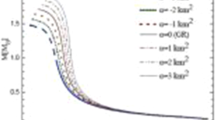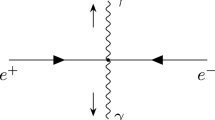Abstract
We consider the effect that the gravitational field of a neutrino pulse radiated in the collapse of presupernova nuclei has on the observable optical radiation spectra of atoms at the supernova surface. We show that at the modern level of development of experimental methods, neutrino monitoring supplemented by optical monitoring of supernova candidates provides a unique possibility to check whether the Einstein equivalence principle is satisfied for neutrinos of each of the three types (electron, muon, and tau-lepton) and their antiparticles, to estimate the change of the gravitational potential at the surface of the star at the instant of the neutrino radiation pulse, and to obtain upper limits on the mass values of these neutrinos in a new way.
Similar content being viewed by others
REFERENCES
F. C. Witteborn and W. M. Fairbank, Phys. Rev. Lett., 19, 1049 (1967).
J. W. T. Dubbs, J. A. Harwey, D. Paya, and H. Horstmann, Phys. Rev., 139, 756 (1965).
R. Colella, A. W. Overhauser, and S. A. Werner, Phys. Rev. Lett., 34, 1742 (1975).
T. W. Darling, F. Rossi, G. I. Opat, and G. F. Moorhead, Rev. Modern Phys., 64, 237 (1992).
V. S. Imshennik and D. K. Nadezhin, Usp. Fiz. Nauk, 156, 561 (1988).
D. R. O. Morrison, “Review of supernova 1987A,” Preprint CERN/EP 88-9, 26 January, 1988, CERN, Geneva (1988).
K. S. Hirata, T. Kajita, M. Koshiba, et al., Phys. Rev. Lett., 58, 1490 (1987).
G. T. Zatsepin and O. G. Ryazhskaya, Sov. Phys. Usp., 28, 726 (1985).
P. C. Vaidya, Proc. Indian Acad. Sci. Math. Sci., 31, 264 (1949).
S. Chandrasekhar, The Mathematical Theory of Black Holes, Oxford Univ. Press, New York (1983).
V. I. Grigor'ev and I. P. Denisova, “Parametric method for integrating geodesic motion equations in the Vaidya space [in Russian],” Preprint No. 2000-11/615, NIIYaF, Moscow State Univ., Moscow (2000).
I. P. Denisova and A. A. Zubrilo, Gravit. Cosmology, 6, 251 (2000).
O. S. Ivanitskaya, Lorentz Basis and Gravitational Effects in the Einstein Theory of Gravity [in Russian], Nauka i Tekhnika, Minsk (1979).
C. M. Will, Theory and Experiment in Gravitational Physics, Cambridge Univ. Press, Cambridge (1981).
T. Neunhoffer, “AMANDA: Current status,” in: Proc. 27th Intl. Cosmic Ray Conf. (edK. H. Kampert, G. Heinzelmann, and C. Spiering, eds.), Copernicus Gesellschaft, Hamburg (2001), p. 1125.
G. T. Zatsepin, JETPLetters, 8, 205 (1968).
Author information
Authors and Affiliations
Rights and permissions
About this article
Cite this article
Denisov, V.I., Denisova, I.P. & Svertilov, S.I. A Possibility for Studying Gravitational Properties of the Neutrino. Theoretical and Mathematical Physics 138, 142–149 (2004). https://doi.org/10.1023/B:TAMP.0000010642.45121.a0
Issue Date:
DOI: https://doi.org/10.1023/B:TAMP.0000010642.45121.a0




